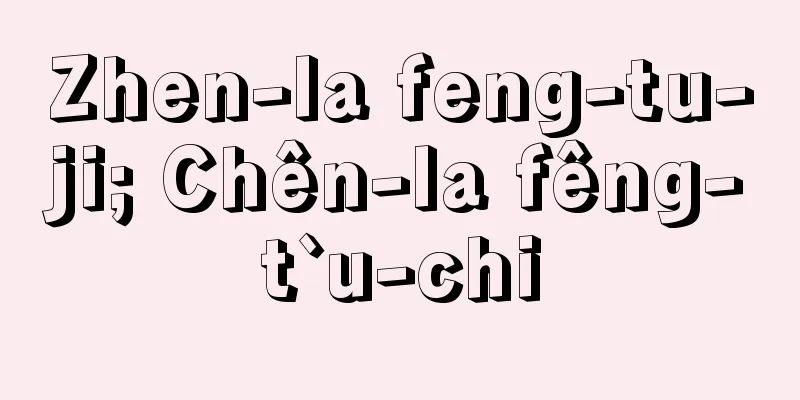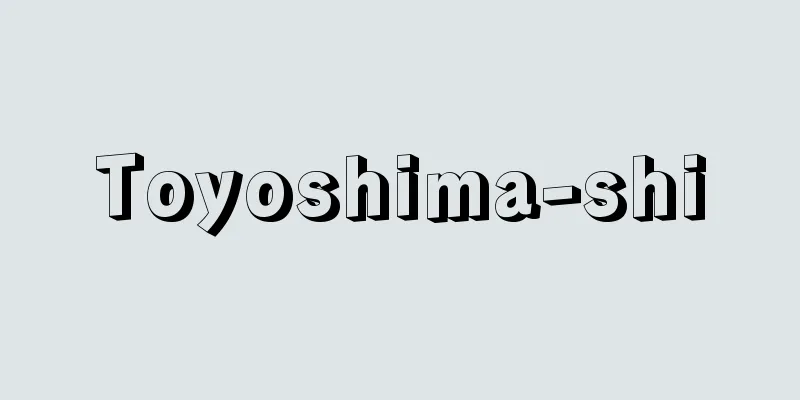Bonsai - Bonsai

|
In the current social consensus, bonsai refers to plants planted in ceramic pots or other containers that express the grandeur, elegance, delicacy, and other impressions one gets from natural scenery, and is distinct from so-called potted plants, which are directly appreciated for their natural shape, color, fragrance, etc. This differentiation of the concept began among a certain group of people around 1887 (Meiji 20), and took about 40 years to become the accepted understanding. In China, the character bonsai has not been used since ancient times. Instead, the words "bonka" from the Tang Dynasty and "bonkei" later came to refer to bonsai in the broad sense (bonsai and potted plants). [Ryoji Iwasa] historyBonsai originated in China and is thought to have been brought to Japan during the process of introducing advanced Chinese culture, beginning with the Japanese missions to Sui and Tang China. In the tomb (704) built by the fourth emperor of the Tang Dynasty, Zhongzong, for his deceased brother, Prince Zhanghuai, Li Xian, three bonsai (flat bowls with stones, thought to be yellow-glazed or white porcelain) are depicted being held by court ladies and servants, and a green-glazed deep bowl was also excavated. The great poet Bai Juyi of the mid-Tang Dynasty wrote a poem about his house in Luoyang, "A Newly Roofed House," in which he included the verse, "(Late autumn) I put the bonsai in a warm room (a low-rise greenhouse = pit)," recording the name of the house at the time and how to protect it from the extreme cold and dryness of winter. Masterpieces of flower trays fired at the Jun kilns and Ru kilns of the Northern Song dynasty are on display at the National Palace Museum in Taipei, which suggests that bonsai appreciation was popular at the imperial court and its surrounding areas, but the popularity of bonsai in later Southern Song dynasty was recorded in publications such as "Records of the Wuxing Gardens," "Annual Affairs of the Wulin," and other publications. Furthermore, from the end of the Heian period through the Kamakura period, there was frequent travel between Japan and the Southern Song Dynasty among people including merchants and monks, and during this process the profound literary elegance of Zen Buddhism and the Southern Song Dynasty (the refined state of mind of the literati and their appreciation of nature above the mundane) was strongly transmitted and developed in a variety of ways. Japanese historical documents begin in the early Heian period, which corresponds to the late Tang Dynasty, with a record that "in May of the 6th year of the Jowa era (839), Shikimatsu, a farmer from Shiki County, Kawachi, saw that a tachibana tree measuring over two inches in height in his garden had bloomed, so he planted it in an earthenware vessel and presented it to Emperor Ninmyo as a sign of good fortune" (Shoku Nihon Koki). In the middle period, the custom of planting Japanese silver grass, bush clover, and other plants in long chests (boxes for storing clothes, etc.) and then viewing them and giving them as gifts became popular among courtiers (Kagero Nikki, Makura no Soshi). In the later period, during the reign of Emperor Horikawa, the retired Emperor Shirakawa held a kind of "senzai awase" (arrangement of artificial flowers) at Toba-in Temple in which participants competed to see who could make the best looking "artificial flowers" (flowers such as bush clover and silver grass planted in a chest) (Kokonchomonju). [Ryoji Iwasa] Bonsan and potted treesIn this social climate, the "Saigyo Monogatari Emaki," painted in the early Kamakura period (around 1200?), captures a "bonsan" (an old name for rock-mounted bonsai) decorating the veranda of the hojo (the residence of the chief priest), eloquently illustrating the origins of bonsai in two ways: from the temple as a place and from the rock-mounted style. In the middle of the Kamakura period, the Song monk Kyodo Kakuen came to Japan as an attendant of Mugai Sogen, the founder of Engakuji Temple. Kakuen praised the beauty of the sekisho (stone lilies) that grew in the depressions of water stones placed in a water basin, and left behind a poem entitled "Bonsekisho (stone lilies)". The jasper basin in question is a type of celadon called Kinuta celadon, fired in the Longquan kiln in Zhejiang. Longquan porcelain was imported in large quantities from the end of the Heian period to the Muromachi period, and the various Longquan pots found among the large amount of ceramics bound for Japan that were salvaged in 1976 from a sunken ship (Wonsen, wrecked in 1323) off the coast of Sinan, Korea, once again recalled the circumstances of the past. Furthermore, poems and prose such as "Bonmatsu, Bonbai, Bonsekisho" scattered throughout the texts of Gozan literature, which flourished from the mid-Kamakura period to the end of the Muromachi period, attest to the high prevalence of bonsai appreciation that flourished particularly in Zen temples. At the beginning of Gozan literature, the character "bonsai" also appeared on paper, but it was not until the mid-Edo period that it began to be used in common usage. In the picture scrolls completed at the end of the Kamakura period, "Eden of Ippen Shonin" (Kankikoji version), "Illustrated Activities of Honen Shonin" (Chion-in version), and "Kasuga Gongen Reigenki," bonsai trees and hachinoki (bonsai without stones) are depicted in accordance with the syllabary, and further into the Nanboku-cho period, they were also featured in images of "Festival Illustrated Books," "Eden of the Saints of Hongan-ji" (Gugam version), and "Boki Ekotoba." In such a social climate, the essay ``Tsurezuregusa'' from the end of the Kamakura period records that the nobleman Hino Suketomo once planted a particularly twisted tree in a pot, and the Noh piece ``Hachi no Ki'', which is said to have been written around the time of Ashikaga Yoshimitsu, the third shogun of the Muromachi shogunate, depicts the tree as belonging to a certain social class, the variety of tree species, and the careful care given to the tree in a pot. During the period of his reign, the eighth Shogun, Ashikaga Yoshimasa, was obsessed with bonzan (mountain climbing trees), and often had bonzan (mountain climbing trees) cultivated by monks from the Gozan and other temples submitted to the Imperial Palace, where he kept some of them for viewing and occasionally modifying them. These included a shallow wooden box (old name: boat) filled with water and a rock-topped display of a Japanese juniper, a Japanese red pine, and a Satsuki azalea (?), as well as flat bowls made of celadon (Ryuzen porcelain?), bronze (old name: kodo), and brass (shinchu) (brass stone) with stones of Dendrobium moniliforme, Horsetail, Yellow Hosta, and Urahagus (?) (Inryoken Nichiroku). Leaving aside the boat mentioned above, it is thought that the celadon and bronze flat bowls were imported from overseas during the Kango trade, and that some of them were handed down by successive rulers. The aforementioned passage in the "Nichiroku" which states that "an empty bowl will be sent to the storehouse" reveals Yoshimasa's extremely important attitude towards his subjects. [Ryoji Iwasa] The Rampant CuriosityIn the Edo period, horticulture began to develop as a trend, with feudal lords and vassals of the Shoguns Tokugawa Ieyasu, Hidetada, and Iemitsu following in their footsteps and acquiring and presenting rare flowers. In addition, the alternate attendance system, which was institutionalized during Iemitsu's reign, created an opportunity for each domain to compete with each other for rare flowers and unusual trees, giving rise to a trend of seeking the unusual and seeking the unusual. Meanwhile, by the time of the Genroku period (1688-1704), common people also followed the example of the government, against the backdrop of social stability and improved standards of living, and the aforementioned color of the times in horticulture intensified to an unexpected degree, encompassing all classes, from high to low. As a result, the commonness that characterizes Edo culture became imbued with decadence and reached its height of prosperity during the Kansei, Kyowa, Bunka, and Bunsei periods (1789-1830), when speculation was rampant in the hope of making a fortune on rare items. The focal items, Karatachibana and Omoto, were priced at exorbitant prices of 100 to 300 ryo (approximately 5 to 15 million yen). Amid this frenzy, connoisseurs wanted fine, expensive bowls worthy of the reputation of rare items, so Seto ware, which boasted mass production, fired ceramic bowls with reliefs and nail carvings around the Kansei period (1789-1801), and elaborate blue-and-white bowls after the Kyowa period (1801-1804), when pottery was replaced by porcelain. In the midst of this, blue-and-white bowls were also sold commercially in Imari, a leading area of ware, and Kyoto porcelain bowls and soft ceramic Raku ware bowls also became available on the market. Up until the first half of this period, bonsai in the city of Edo was in both name and reality an extension of the Muromachi and Azuchi-Momoyama periods, but after that, in response to the public craze for unusual items, it moved towards the use of strange shapes (such as octopus-shaped, root-growing, and bamboo-growing) and ornate deep pots for these unusual items, and as can be seen in ukiyo-e and magazines of manners and customs, the elegance sought in modern bonsai was generally not taken into consideration. [Ryoji Iwasa] Literary BonsaiApart from this trend, around the middle of the Edo period, highly knowledgeable people outside of academia who gathered in Kamigata (Kyoto and Osaka) were belatedly creating a Chinese literati-style realm (the elegant realm of Bunpo Seigan, the koto and chess, painting and calligraphy) using works such as "Kohan Yoji" from the end of the Ming Dynasty, "Hiden Kakyo" and "Kaishien Gaden" (a picture manual for painting in the Southern School) from the beginning of the Qing Dynasty, and others. They displayed bonsai (literati bonsai, literati plants) that were different from the bonsai of the general public and aimed for elegance on their desks in their studies, and were immersed in the profound interest of sencha tea. It is assumed that the term bonsai was first used as new knowledge at that time through the pages of "Hiden Kakyo." [Ryoji Iwasa] From artistic bonsai to natural beauty bonsaiAfter the Meiji Restoration (1868), the nobles, feudal lords, and patriots who were loyal to the Imperial faction and appointed to important positions in the new government ordered literati bonsai cultivated in the Ikeda region of Settsu to embody the refined world of Sencha tea that they had acquired in the Kamigata region, where they had worked hard to restore the Imperial rule, in the new capital of Tokyo. The interest in literati bonsai that began there rapidly developed behind the scenes of a society that was rushing to become more civilized and Westernized, and it spread as a status symbol among the upper classes such as the Imperial family, the aristocracy, and powerful vassals, and then among the heads of newly emerging zaibatsu and small business owners. Art critic Ernest Fenollosa, who came to Japan in 1878 (Meiji 11), cooperated with Okakura Tenshin in a time when the aftereffects of the Shinto-Buddhist separation movement were intensifying, leading to the abolition of Buddhism. He enthusiastically promoted the art movement, hoping to open the eyes of Japanese people to their own cultural heritage. Some bonsai artists who followed the trend of the time came up with the idea of improving the simple and elegant appearance of literati bonsai in accordance with the pages of "The Mustard Seed Garden," and showed the results of their efforts in the aptly named Fine Art Bonsai Exhibition held in 1892. As the art of bonsai, which makes the most of the value of Yixing pots (Japanese name: clay pots) imported from Jiangsu, China, began to attract attention, Ikushima Hajime, editor-in-chief of the Yorozu Choho newspaper, and others, took various natural tree shapes as examples of arranging trees to replace those in the Gaden magazine, and around 1897, they started to introduce what Kobayashi Toshio later called "natural beauty bonsai" and a method of adding undergrowth to the main tree. This was the beginning of the diverse patterns and display methods of modern bonsai. With this shift at the end of the 19th century as a backdrop, the number of bonsai enthusiasts increased rapidly, and bonsai clubs were formed in various places, mainly by professionals, and two or three journals were subsequently published. Norio Kobayashi, who later became the editor of the magazine Bonsai (first published in 1921), was devoted to improving the quality of bonsai and raising awareness of it through the pages of the magazine and by frequently holding public exhibitions. He also came to see bonsai as a living art unique to Japan, and in 1934 (Showa 9) founded the Kokufu Bonsai Exhibition, the largest event in the bonsai world that is still held today, at the Ueno Museum of Art. [Ryoji Iwasa] Spreading to the worldJapanese bonsai was transported to Western Europe on the wave of plant hunting that was taking place on a global scale after the opening of ports at the end of the Edo period. However, due to the lack of familiarity with bonsai, their strange appearance led to scorn as "strange things that go against nature," and only the age of the tree left an impression as the long years of hard work put into the bonsai. However, in Japan, it was later upgraded to art bonsai and natural beauty bonsai, and Westerners gradually became familiar with it, so its reputation gradually improved. It was the soldiers from various countries who were stationed in Japan after World War II who once again established its popularity worldwide. People from all over the world who came to Japan for the Tokyo Olympics (1964) and Expo '70 visited the special exhibition of masterpieces of bonsai and suiseki, which decisively fulfilled the longing for bonsai that arose from the stories of soldiers returning home as souvenirs. Moreover, behind this satisfaction was a hidden awakening to a higher spiritual realm of Japanese artistic outlook that had never existed in Japan before - adhering to the inherent qualities of natural materials, making slight modifications to enhance aesthetic sensations. The international word BONSAI was born from the deep impressions that visitors received. In recent years, bonsai enthusiasts have appeared in many countries around the world, and many societies have been formed. Also, in response to a request from the United States to commemorate the 200th anniversary of the founding of the country last year, the United States presented the country with a masterpiece of a bonsai suiseki (1975). These developments are signs of the global expansion of bonsai. [Ryoji Iwasa] kindsThere are three ways to classify bonsai: (1) by tree species, (2) by tree shape, and (3) by size. [1] They can be classified according to tree species as shown in the tree species classification . [2] Classification by tree shape This was done for convenience after many tree shapes had been created throughout the history of bonsai's origins and development. Straight trunk: This is the basic bonsai tree shape, and there is a wide range from thick, majestic trunks to slender, elegant trunks. Moyogi: A type of tree with a natural curve in the trunk, and is quite numerous. A clump of trees: Several trunks grow from a small area and are made up of a single individual. They can also symbolize forests. Netsuranari: Made up of a single individual, many trunks grow up over a wide area to form a forest. Half-cliff-hanging: A tree shape that resembles a tree leaning over a cliff, with the bottom of the tree higher than the top of the pot. Kengai: A tree that hangs over a cliff and whose tip hangs lower than the top of the pot. A collection of several or several dozen plants is used to represent a forest. It is easy for anyone to understand, even if they do not know any complicated rules. Houki-dachi: A tree with a nearly straight trunk and branches that spread out radially at the top. A typical example of this type of tree is the Zelkova. Bankan: A tree with a twisted trunk and a complex appearance. A severe appearance caused by the effects of wind and snow. Slanted trunk: A tree shape in which the trunk is tilted at an angle due to the influence of wind, other trees, cliffs, etc. A windsock that grows to one side due to the influence of a strong wind. It can be seen in both single-trunked and multi-trunked trees, and was created in modern times. Soukan: A trunk that splits into two from the bottom. Both straight and curved trunks can be seen. Sankan: A tree shape in which the trunk splits into three from the base. It looks wonderful when each trunk is well balanced. Neagari: A tree shape in which the soil around the roots has been washed away, exposing the roots. This shape gives the impression of the tree's strong vitality. Ishitsuki: A tree shape that expresses the way trees grow on cliffs or islands. There are various variations, including those that live only on rocks and those that put their roots down from the rock into a pot. Bunjin bonsai (Bunjin tree) This can be said to be a type of tree form that expresses one's imagination, and can also be called a free form, but it is generally interpreted as a light, elegant and refined tree form. [3] Classification by size In essence, classification by size does not have much meaning, but in practice they are often separated for purposes such as cultivation, transportation, and display. (1) Large bonsai: This refers to bonsai with an above-ground height of 50 centimeters or more. There are some exceptions depending on the shape of the tree. (2) Medium-sized bonsai: This refers to bonsai with an above-ground part that is 30 centimeters or more and 50 centimeters or less. (3) Small bonsai: A bonsai whose above-ground part is between 10 centimeters and 30 centimeters long. (4) Small bonsai (small bonsai, miniature bonsai): This refers to bonsai with an above-ground part of 10 centimeters or less. [Nakamura Toru] How to make itMaterialsVarious materials are needed to cultivate and shape bonsai, and many have been developed for that purpose. [1] Tools: First, there are small saws for cutting thick roots and branches, followed by pruning shears, medium-sized pruning shears, bud-picking shears (also used for leaf cutting), large and small wire cutters, pliers, levers, tree trimmers, large and small branch cutters, various types of knot cutters, various chisels, tweezers, root-cutting sickles, root-untangling rakes, cutting knives, soil containers, brooms, sieves, watering cans, turntables, etc. Materials include pots, stones for attaching stones, flat stones, wire for shaping, bottom netting, fertilizer, various types of soil, and various healing agents that can be applied to the pruning cuts of branches and trunks to protect and promote healing. [2] Soil The soil for bonsai is the most important of all the materials. In addition to fixing the bonsai tree in the pot, the soil also serves to retain moisture and nutrients and gradually supply them to the bonsai tree. The microorganisms and chemicals in the soil also convert nutrients supplied from the outside into a form that is easily absorbed by the plant, helping the bonsai tree grow. The growth of bonsai trees is regulated by the size and type of soil particles. Small-grained soil encourages the development of capillary roots, which also work to produce many small branches. Coarse-grained soil produces fewer thick roots and coarse branches. Hard soil hardens the wood and makes the bark coarse. In this way, soil has a major impact on the shape of a bonsai tree, which is an important aspect of its appreciation. Therefore, it can be said that bonsai soil is deeply connected to the essence of bonsai. In recent years, due to the rapid distribution of bonsai, the spread of knowledge about bonsai, and the ease of transporting soil, it has become common to purchase soil from other regions and mix it with local soil to take advantage of the advantages of each. The soil produced in various regions is as follows: Akadama soil is a volcanic red soil found throughout the Kanto region, which is crushed and sifted before use. It has the right hardness, moisture and fertility, making it suitable for all tree species. It is mixed with other soils depending on the purpose, but it is the most reliable in terms of production volume and quality, making it the best soil. Kanuma soil is found in the Kanuma region of Tochigi Prefecture, and is yellowish brown when dry, turning yellowish white when dry. It is highly water-absorbent and has good ventilation, making it ideal for cuttings, and is especially useful for plants of the Ericaceae family. Kiryu sand (Kiryuzuna) Produced in Tochigi Prefecture, it is brown and turns yellowish brown when dry. It is harder than Akadama soil and Kanuma soil, and holds water well and has good drainage. It is rarely used alone, but is often mixed with Akadama soil. Fuji sand (Fujizuna) is weathered lava from the Fuji volcano and is mixed with Akadama soil. It is available in purple-black and reddish brown varieties and is often used to cultivate mountain plants. Yahagi River Sand (Yahagigawa Sand) Produced in the Yahagi River, Aichi Prefecture. It is a sand with white quartz and sharp edges. It is heavy and used alone for all potted plants in the production area, but since it quickly roughens the bark, it is suitable for most tree species if mixed with soft soil. Bora: Produced in volcanoes in Kyushu and parts of the Tohoku region, it is light when dried and has properties similar to Kanuma soil. It is widely used in the Kyushu region, but is also used in other regions because it is easy to transport. In addition to the above, there are many types of soil and sand that are used only in each region. In addition to natural soil, other types of soil that have been put into practical use include porous ball-shaped clay balls made by baking and hardening soil, vermiculite made from baked vermiculite, perlite, various plastic products, and slag products, all of which are particularly excellent in terms of their air content. [Nakamura Toru] Key points of cultivation and shapingBonsai cultivation and shaping are like the two wheels of a cart. If either one is missing, the cart will not have perfect ornamental value. Furthermore, the two are inseparably linked. [1] Cultivation The important things to keep in mind when cultivating bonsai are daily irrigation, fertilization, and spraying of pesticides, as well as seasonal repotting, bud removal, pruning, and leaf thinning. [2] Shape The aspects to be appreciated in bonsai include (1) root spreading (the appearance of the roots firmly established above the ground), (2) trunk pattern (the changes in the curvature of the trunk and how it tapers from bottom to top), and (3) branch arrangement (the placement and angle of the branches), which give variety to the plant's appearance and affect its ornamental value. There are various rules for bonsai, and understanding these is the quickest way to understand them well. The front is determined as the position from which the bonsai is viewed. The front is the position from which the bonsai is most appreciated overall. As an easy way to determine the front, I have devised the "100-point method." In other words, the four elements that determine the front - root arrangement, trunk pattern, branch arrangement, and forward leaning posture - are assigned 30, 30, 30, and 10 points respectively, and the position with the highest overall score from the surrounding area is determined to be the front. [3] Material It has long been said that "70% of a bonsai depends on the material." This means that 70% of a bonsai's quality depends on the material. A good seed tree is healthy, has many attractive features, has good roots, a good upright shape, and a good trunk pattern, with many branches that are well-positioned, and the trunk gradually becomes thinner toward the top, is not stretched, has no major blemishes, has good leaves and bark, and has strong sprouting power. [4] Basics of tree shaping Materials are designed to maximize their strengths and minimize their shortcomings, and are pruned and shaped to approximate the desired shape. The most important guideline for pruning is the use of dead branches. [Nakamura Toru] Points to note when viewing(1) Observe the sense of the season and the characteristics of the tree species. It is important that the characteristics of the plant material, such as the beauty of flowers, fruits, new buds, and autumn leaves, are well displayed. (2) Cultivation Condition Healthiness always takes precedence over everything else. Pathological or deformed plants are not valued in orthodox bonsai. (3) Tree structure The framework of a bonsai tree is also called the grain of the tree, and is the foundation of the bonsai. Even leaves, flowers, and fruits can be appreciated in the fall, and they must have sufficient ornamental value. (4) Pot reflection, display style and accessories It is important for a bonsai to blend in with the pot in which it is planted, and this is called pot reflection. The size, shape, color and texture of the pot in relation to the bonsai are important. When appreciating a bonsai, it is placed on a table in a fixed location that matches the bonsai, and accessories such as grasses and water stones are placed on the base, and sometimes it is displayed with a hanging scroll. The space dominated by these things is to be appreciated. (5) Period The antique color that appears in the bonsai, pots, accessories, etc. is called the period, and the simple taste is the subject of appreciation. It is related to the state of wabi-sabi that has been said since ancient times. [Nakamura Toru] "Bonsai Cultural History" by Iwasa Ryoji (1976, Yasaka Shobo)" ▽ "Bonsai Encyclopedia" (1983, Dohosha Publishing) ▽ "Bonsai Handbook" edited and published by the Japan Bonsai Association (1980) ▽ "Illustrated Regional Bonsai Care Calendar" edited by Garden Life (1982, Seibundo Shinkosha) ▽ "Your First Shohaku Bonsai" by Nakamura Susumu (1981, Shufu to Seikatsusha) ▽ "How to Train Bonsai" by Oyama Reiron, 6 volumes (1971, Taibunkan) A bonzan (a mountain) is placed on a platform on the veranda. A strangely shaped rock with a small tree on it is placed on it. "Kasuga Gongen Miracle Record" (detail) Copy held at the National Diet Library "> Bonsai in the Kasuga Gongen Miracle A potted tree depicted in a picture scroll from the Northern and Southern Courts period. A stand is made of green bamboo in the garden, and the pot is placed on top of it. "Boki Ekotoba" (part) Copy held at the National Diet Library "> Bonsai in the "Mokie-kotoba" ©Shogakukan "> Bonsai tree species classification (table) ©Shogakukan Library "> Classification of bonsai by tree shape ©Shogakukan "> Examples of Bonsai Cultivation and Shaping Methods (1) Repotting ©Shogakukan "> Examples of Bonsai Cultivation and Shaping Methods (2) Pruning ©Shogakukan "> Examples of Bonsai Cultivation and Shaping Methods (3) Bud Removal ©Shogakukan "> Examples of Bonsai Cultivation and Shaping Methods (4) Wiring ©Shogakukan "> stubborn ©Shogakukan "> Main bonsai tree species culture management table (pine oak) ©Shogakukan "> Main bonsai tree species cultivation management chart (miscellaneous trees - leafy plants) ©Shogakukan "> Main bonsai tree species cultivation management chart (miscellaneous trees - flowering plants) ©Shogakukan "> Main bonsai tree species cultivation management chart (miscellaneous trees - actual items) Source: Shogakukan Encyclopedia Nipponica About Encyclopedia Nipponica Information | Legend |
|
現代の社会通念では、陶磁鉢その他の器物に植えた草木が、自然の景観から受ける豪壮、佳麗(かれい)、繊細などの感興を表現する場合を盆栽とよび、植物体本来の形、色、香りなどを直接的に観賞する、いわゆる鉢植えと区別する。そのような概念の分化は、1887年(明治20)ごろ一部の人々の間に発端し、その後ほぼ40年を要して通念化した。 中国では、古来、盆栽の文字は通用せず、かわって、唐代の「盆花」、その後の「盆景」が、広義の盆栽(盆栽と鉢植え)にあてられてきた。 [岩佐亮二] 歴史盆栽は中国に生まれ、日本へは遣隋使(けんずいし)・遣唐使に始まる中国の先進文化導入の過程でもたらされたと考えられる。 中国、唐第4代皇帝中宗が、亡兄章懐太子(しょうかいたいし)李賢(りけん)のために営造した陵墓(704)に残る壁画には、宮女、下人の捧持(ほうじ)する盆花3点(黄釉(おうゆう)、白磁などとみられる平鉢の石付き盆栽)が描かれ、また緑釉の深鉢1点も出土した。中唐の詩聖白楽天(はくらくてん)は、洛陽(らくよう)に構えた住宅につき、「新葺(しゅう)新居」を詠み、そのなかに、「(秋末)盆花を暖室(低設温床=地窖(ちこう))に入れる」との詩句を挟んで、当時の呼称と冬の酷寒過乾からの保護法を記録した。北宋(ほくそう)代の鈞窯(きんよう)と如窯で焼成された花盆の名品が故宮博物院(台北)にあり、宮廷とその周辺で盆栽賞玩(しょうがん)が盛行していた事情を推察させるが、後年の南宋における盛況は、『呉興園林記』『武林旧事』その他の紙面に載った。 なお、日本と南宋の間には平安末から鎌倉時代にかけて、商人・僧侶(そうりょ)をはじめとする人々の頻繁な往来があり、その過程で禅宗と南宋の深遠な文雅(文人の高雅な境地と超俗自然賛美の思潮)が色濃く伝えられ、多彩な展開をみた。 日本の史料上では、晩唐にあたる平安初期、「承和(じょうわ)6年(839)5月、河内(かわち)志紀郡の百姓志紀松は、庭に生ずる高さ2寸余の橘(たちばな)が花をつけたので、土器に植えて、(瑞徴(ずいちょう)として仁明(にんみょう)天皇に)献上した」(続日本後紀(しょくにほんこうき))との記録に始まり、中期には、長櫃(ながびつ)(衣服などの格納箱)にススキ、ハギなどを植えて観賞し贈答する風習が、宮廷人の間で盛行した(蜻蛉(かげろう)日記、枕草子(まくらのそうし))。後期にあたり、堀河(ほりかわ)天皇の治世、白河(しらかわ)上皇は、鳥羽(とば)院で、「作り花」(長櫃に配植したハギ、ススキなど)のできばえを競う一種の「前栽合(せんざいあわせ)」を催した(古今著聞集(ここんちょもんじゅう))。 [岩佐亮二] 盆山と鉢木そうした世情のなかで、鎌倉時代初頭(1200ころ?)に描かれた『西行(さいぎょう)物語絵巻』が、方丈(ほうじょう)(住職の居住棟)の縁先を飾る「盆山(ぼんさん)」(石付き盆栽の古称)を写し留めたことは、場所としての寺院、様式としての石付きの二面で、盆栽が登場した由来を雄弁に物語る。 鎌倉時代のなかば過ぎ、宋僧鏡堂覚円は、円覚寺(えんがくじ)の開山(かいざん)無学祖元の侍者として来日したが、覚円は水盤中に据えた水石のくぼみに生ずるセキショウ(石菖)の風趣を賞して、「碧玉盤(へきぎょくばん)中水石間……」とする詠懐『盆石菖(ぼんせきしょう)』を残した。その碧玉盤は浙江(せっこう)の竜泉窯で焼成する和名砧(きぬた)青磁である。なお、その竜泉磁は、平安末から室町時代にかけて多量に輸入されていたが、1976年韓国新安沖の沈船(元船、1323年に難破)から引き上げられた日本向けの多量な陶磁中に介在する多様な竜泉鉢は、改めて往年の事情を想起させる。 なお、鎌倉中期から室町時代末まで盛んであった五山(ござん)文学の文面に散在する『盆松・盆梅・盆石菖』その他の詩文は、禅林内でひときわ栄えていた盆栽賞玩の高風を傍証する。なお五山文学草創のころ、「盆栽」の文字も紙面に載ったが、それが通用し始めたのは江戸中期であった。 鎌倉時代末に完成した絵巻、『一遍上人(いっぺんしょうにん)絵伝』(歓喜光寺本)、『法然(ほうねん)上人行状絵図』(知恩院本)、『春日権現霊験記(かすがごんげんれいげんき)』には、符節をあわせて、盆山と鉢木(はちのき)(石を添えない盆栽)が描かれ、さらに続く南北朝時代にもずれ込んで、『祭礼絵草子』、『本願寺聖人(しょうにん)伝絵』(弘願(ぐがん)本)、『慕帰絵詞(ぼきえことば)』の画面にも載った。そのような世情のなかで、鎌倉末の随筆文学『徒然草(つれづれぐさ)』は、公家(くげ)日野資朝(すけとも)が一時期ことさらに曲折のある木を鉢に植えた旨を記し、室町幕府の3代将軍足利義満(あしかがよしみつ)のころとされる謡曲『鉢の木』は、想定した辺境の郷士に仮託して、受け入れ階層、樹種の多様、行き届いた手入れを曲譜に上らせた。 8代将軍足利義政(よしまさ)は、青壮の一時期、盆山に凝り、しばしば五山その他の寺僧が培養する盆山を御所に提出させ、そのなかのいくつかを手元にとどめて観賞し、ときに改作の手を加えた。それらは、水をたたえた浅い木箱(古称、船)に据えた岩上のミヤマビャクシン・ゴヨウマツ・サツキ(?)、青磁(竜泉磁?)・青銅(古称、古銅)・真鍮(しんちゅう)(鍮石(ちゅうじゃく))の平鉢に配したセッコク・トクサ・キボウシ・ウラハグサ(?)の石付きなどであった(『蔭凉軒日録(いんりょうけんにちろく)』)。上記の船はさておき、青磁と銅器の平鉢は、勘合貿易による当時の渡来品に、一部、歴代の支配者に由来する伝世品が加わったとも考えられる。前記した『日録』が「空(から)鉢をお蔵(くら)に遣わす」とした条章に、ひときわ貴重視していた義政の姿勢が秘められていた。 [岩佐亮二] 奇品の横行江戸時代の園芸は、将軍徳川家康・秀忠(ひでただ)・家光(いえみつ)が無類の花好きであったことを受けて、大名・旗本による追随、珍花の入手と献上が時流として進展し始めた。加えて、家光の治世に制度化された参勤交代は、各藩が互いに珍花奇木を競い合う場を形成した点で、奇を追い異を求める潮流を派生した。一方庶民の側も、元禄(げんろく)(1688~1704)のころまでには、世情の安定、生活の向上などを背景に、お上(かみ)に倣ったので、園芸上の前記した時代色は、上下各層を網羅して、意表を絶するまでに激化していった。そのあげく、江戸文化を特徴づける庶民性が、退廃性をはらんで、爛熟(らんじゅく)の極に達した寛政(かんせい)・享和(きょうわ)・文化(ぶんか)・文政(ぶんせい)期(1789~1830)には、奇品に一攫(いっかく)千金の夢を賭(か)ける投機が世上に横行した。焦点のカラタチバナとオモトの貴品には、100両から300両(およそ500万~1500万円)の法外な呼び値がつけられた。そのような狂騒のなかにあった好事家(こうずか)は、奇品の評価に見合う精良高価な鉢を欲したので、量産を誇る瀬戸焼は、寛政(1789~1801)のころには浮彫り・釘(くぎ)彫りの陶器鉢を、陶器を磁器に改めた享和(1801~1804)以降には、手のこんだ染付鉢(そめつけばち)を焼成した。そうしたなかで、先進地伊万里(いまり)でも染付鉢を市販し、また京焼の磁器鉢と軟質陶器の楽焼鉢も市中に出回った。 江戸市中の盆栽は、この時代前半のころまで、名実ともに室町・安土(あづち)桃山時代の延長であったが、その後は、世上の奇品熱を受け入れる形で、奇異な整姿形(蛸(たこ)作り、根上り、篠(しの)作りなど)と奇品用の華美な深鉢の供用へと進み、浮世絵、風俗誌などにみられるように、総じて、現代の盆栽に求められる風趣は考慮の外にあった。 [岩佐亮二] 文人盆栽そのような大勢とは別に、江戸中期のころ、上方(かみがた)(京・大坂)に参集する在野の高識者は、遅まきながら、中国文人流の境地(文房清玩(ぶんぽうせいがん)・琴棋(きんき)書画の雅境)を、明(みん)末の『考槃(こうはん)余事』、清(しん)初の『秘伝花鏡』、『芥子園画伝(かいしえんがでん)』(南宗画の絵手本)その他によって構成し、世上一般の盆栽とは異質な簡雅を旨とする盆栽(文人盆栽、文人植木)を書斎(文房)の机上に飾り、煎茶(せんちゃ)にまつわる深遠な興趣に浸った。なお盆栽の呼称は、その時点で『秘伝花鏡』の紙面から新知識として広まったと推察される。 [岩佐亮二] 美術盆栽から自然美盆栽へ明治維新(1868)後、新政府の要人に登用された勤王派の公家(くげ)、大名、志士は、かつて王政復古に奔走していた上方で身につけた煎茶の雅境を新首都東京で体現するため、摂津の池田地域で養成する文人盆栽を取り寄せた。そこに始まった文人盆栽への志向は、文明開花、欧風化に走る世情の裏側で急速に展開し、皇族、華族、権臣などの上層階級に、続いて、新たに台頭してきた財閥の当主、中小企業主の間に、地位の象徴として浸透していった。 1878年(明治11)に来日した美術評論家アーネスト・フェノロサは、文明開化・神仏分離の余波が廃仏棄釈へと激化した世情のなかで、岡倉天心と協力し、日本人が自国の文化遺産に開眼することを願って、美術運動を意欲的に推進した。その時流に添った一部の盆栽家は、文人盆栽の簡雅素朴な姿態を、『芥子園画伝』の紙面に即して向上させることに思い至り、その成果を、1892年に開いた、その名もずばりの美術盆栽展として披露した。中国の江蘇(こうそ)から輸入する宜興(ぎこう)盆(和名、泥物(でいもの)鉢)の真価を生かすその美(芸)術盆栽が世人の関心を集めるなかで、『萬朝報(よろずちょうほう)』の主筆生島一(いくしまはじめ)らは、『画伝』にかわる整姿の手本として、多様な自然の樹形をとり、そこに後人小林憲雄(としお)が名づけた自然美盆栽と、主木に下草を添える方式の兆しとを、1897年ごろに発端させた。それは現代の盆栽がもつ多様な範型と席陳列法の発足であった。19世紀末におけるそのような転進を背景に、盆栽人口が急増し、各地で、業者を中心に同好会が結成され、続いて2、3の機関誌が発刊された。のちに雑誌『盆栽』(1921発刊)を主宰した小林憲雄は、誌面により、また公開の展示会をしばしば催して、盆栽の資質向上と啓蒙(けいもう)に傾倒した。また、彼は、盆栽にわが国固有の生きた芸術との意味をもたせて、1934年(昭和9)、いまに伝わる盆栽界最大の行事国風盆栽展を、上野の美術館を会場として創始した。 [岩佐亮二] 世界への広がり日本の盆栽は、幕末の開港を機に、世界的規模で展開されていた植物探査(プラントハンティング)の波にのって西欧に運ばれた。しかし、それらの奇異を誇示する姿態は、盆栽になじみがなかったことを背景に、「自然に反する奇異なもの」との軽侮を招き、ただ樹齢だけが、盆上に傾注した長年の労苦として、印象に残った。しかし、その後の日本では、美術盆栽、自然美盆栽へと向上し、西欧人もしだいになじみをもってきたので、評価は徐々に好転していった。その好評を改めて世界的に定着させたのは、第二次世界大戦後日本に駐留した各国の将兵であった。東京オリンピック(1964)と日本万国博覧会(1970)に際して来日した世界各国の人々は、特設された盆栽水石の名品展を訪れ、帰国した将兵の土産(みやげ)話に発する盆栽へのあこがれを、決定的に充足させた。なお、その充足の裏には、自国にはかつて存在しなかった日本人的な芸術観――自然の素材に備わる本性に即しながら、わずかに手を加えて、美的感興を盛るという次元の高い精神的領域への開眼が秘められていた。国際語BONSAIは来訪者の受けた深い感銘に源泉した。 近年、世界の各国各地で、盆栽愛好家が輩出し、多数の同好会が結成され、また先年のアメリカ建国200年祭にあたり、先方の要請をいれて、盆栽水石の名品が贈られた(1975)などの事態は、盆栽の地球的規模の展開を表徴するものである。 [岩佐亮二] 種類盆栽を分類するには3種の分け方がある。〔1〕樹種によって分ける方法、〔2〕樹形によって分ける方法、〔3〕大きさによって分ける方法である。 〔1〕樹種別分類 のように分けられる。 〔2〕樹形による分類 これは盆栽が発生、発達の歴史を経て多くの樹形がつくられたのちに、便宜的に行われたものである。 直幹(ちょっかん) 盆栽樹形の基本となるもので、太幹豪壮から細幹優美なものまで幅がある。 模様木(もようぎ) 幹に自然な曲線をもった樹形で絶対数は多い。 株立(かぶだ)ち 狭い範囲から数幹が立ち上がってしかも1個体から成り立っているもの。森林を象徴することもある。 根連(ねつらな)り 1個体から成り立っているが、広い範囲に多くの幹が立ち上がって森林を形づくっているもの。 半懸崖(はんけんがい) 崖(がけ)から乗り出した木の姿を表した樹形で、木の下端が鉢の上端よりも高いものをいう。 懸崖(けんがい) 崖から乗り出した木の先端が鉢の上端よりもさらに低く垂れているものをいう。 寄植(よせうえ) 数個または数十個体を用いて森林を表現するもの。むずかしい約束事を知らなくてもだれにでも理解しやすい。 箒立(ほうきだ)ち 立上りはほぼ直幹で上部は放射状に枝を広げた形。代表的な樹種としてケヤキがあげられる。 蟠幹(ばんかん) 幹が捻転(ねんてん)して複雑な姿をした樹形。風雪などの影響を受けた厳しい姿。 斜幹(しゃかん) 風や他の木、崖などの影響で幹が斜めに傾いた樹形。 吹流(ふきなが)し 強風の影響で一方にだけ育った姿。単幹、多幹いずれにもみられ、近代に創出された。 双幹(そうかん) 幹が下から2本に分かれて育った姿。直幹、曲幹いずれもみることができる。 三幹(さんかん) 幹が元から3本に分かれている樹形。各幹のバランスがうまくとれるとすばらしい。 根上(ねあが)り 根の周囲の土砂が流亡して根が露出した樹形。樹の生命力の強さを想像させる。 石付(いしつ)き 崖や嶋(しま)に樹木が生存する姿を表現した樹形。種々の変化があり、石の上だけで生活するもの、石から鉢に根を下ろすものがある。 文人(ぶんじん)盆栽(文人木(ぶんじんぎ)) 一種の心象表現樹形ということができ、自由形ともいえるが、一般には軽妙洒脱(しゃだつ)な樹形と解釈されている。 〔3〕大きさによる分類 本質的には大きさによる分類はたいした意味はないが、培養、運搬、陳列などのうえで実際には分けられる場合が多い。 (1)大形盆栽 地上部の高さが50センチメートル以上のものをいい、樹形により多少の例外もある。 (2)中形盆栽 地上部が30センチメートル以上、50センチメートル以内をいう。 (3)小盆栽 地上部が10センチメートル以上、30センチメートル以下をいう。 (4)小品(しょうひん)盆栽(小物(こもの)盆栽、豆盆栽) 地上部が10センチメートル以下のものをいう。 [中村 享] 仕立て方資材盆栽の培養、整姿を行うには各種の資材が必要で、そのために開発されたものが少なくない。 〔1〕用具 まず太根、太枝を切る小型の鋸(のこぎり)、順に剪定鋏(せんていばさみ)、中型剪定鋏、芽摘み鋏(葉透かしにも用いる)、針金切り大小、やっとこ、てこ、神(じん)作り、又枝切り大小、こぶ切り各種、のみ各種、ピンセット、根切り鎌(かま)、根ほどきレーキ、切出しナイフ、土入れ、箒(ほうき)、篩(ふるい)、如露、回転台などがある。 資材には鉢をはじめ、石付き用の石、平石、整姿用針金、底網、肥料、各種用土がある。又枝や幹の剪定切り口に塗って保護・癒合を促す各種の癒合剤もある。 〔2〕用土 盆栽の用土は各資材のなかでももっとも重要なものである。用土は盆樹を鉢に固定するほか、水分・養分を保持し徐々に盆樹に供給する役目を果たす。また用土中の微生物、化学物質の働きにより外部から供給される養分を植物の吸収しやすい形に変え、盆樹の生育を助ける。 用土の粒子の大小、用土の種類により、盆樹の生育の調節が行われる。すなわち、小粒の用土は毛細根の発生を促し、それは小枝を多数発生させる働きもする。粗い粒子の用土は少数の太根をつくり、枝を粗くする。固い用土は木質部を固くし、皮肌を粗剛にする。このように用土は、盆樹のたいせつな観賞点である樹姿に大きな影響を及ぼすのである。したがって盆栽の用土は盆栽の本質と深くかかわっているといえよう。 近年盆栽の急速な流通と知識の普及、用土運搬の容易化などの原因から、他地方の用土を購入し、土地の用土と混合してそれぞれの長所を生かした使用が多くみられるようになった。 各地に産する用土をあげれば次のようになる。 赤玉土(あかだまつち) 関東一円に産する火山性の赤土で、砕いてふるい分けて使用する。固さ、含水、含肥性が適度ですべての樹種に好適する。目的に応じて他の用土と混用されるが、産出量、品質ともにもっとも信頼性が高く、最上の用土である。 鹿沼土(かぬまつち) 栃木県の鹿沼地方に産し、黄褐色、乾くと黄白色となる。水をよく含み通気性のよいところから挿木用、ツツジ科の植物にはとくに賞用される。 桐生砂(きりゅうずな) 栃木県産で、褐色で乾くと黄褐色となる。固さは赤玉土、鹿沼土よりも固く、水も含み排水もよい。単用されることは少なく、赤玉土などと混用される。 富士砂(ふじずな) 富士火山の溶岩の風化したもので赤玉土と混用される。紫黒色のもの、赤褐色のものがあり、山草の培養に多く用いられる。 矢作川砂(やはぎがわすな) 愛知県矢作川産。白色石英質の角のある砂である。重量があり産地ではすべての鉢物に単用されているが、木肌の荒れ方が早いので軟質の土と混用すれば大部分の樹種に向く。 ボラ 九州地方および東北地方の一部の火山産で、乾燥すると軽く、鹿沼土とよく似た性質である。九州地方ではもちろん多用されているが、運送に軽便なので各地方で使われている。 以上のほかにも各地方のみで用いられている多種類の土、砂がある。 人工用土 天然の用土のほかに土を焼いて固くした多孔質のボール状のクレイボール、蛭石(ひるいし)を焼いたバーミキュライト、パーライト、各種のプラスチック製品、鉱滓(こうさい)製品なども実用化されており、これらはとくに空気の含有率の点で優れている。 [中村 享] 培養と整形の要点盆栽の培養と整形は車の両輪である。いずれが欠けても完璧(かんぺき)な観賞価値は生じない。また、この両者は互いに不可分の関係がある。 〔1〕培養 盆栽の培養上たいせつなことは日常的には灌水(かんすい)、施肥、薬剤散布などであり、季節的には植替え、芽摘み、剪定、葉透かしなどがある。 〔2〕整姿 盆栽の観賞点に(1)根張り(地上にしっかりと張った根の姿)、(2)幹模様(幹の屈曲の変化と下から上へ順に細くなるようす)、(3)枝配り(枝の配置や角度)があり、姿に変化を与え、観賞価値を左右する。 盆栽には種々の約束事があり、よく理解するためにはこれらを理解したほうが早道である。盆栽が観賞される位置として正面を決める。正面とは、その盆栽の総合的にもっとも観賞価値を認められる位置である。正面を決めるために容易な方法として「100点法」を考案してみた。つまり、正面を決める四つの要素、根張り、幹模様、枝配り、前傾姿勢のもっともよいところを各30、30、30、10点とし、周囲から検討して総合点のもっとも高い位置を正面とするのである。 〔3〕素材 古くから「種木(たねぎ)7割」といわれている。盆栽のできは70%が素材にかかっているというのである。よい種木とは健全であること、人をひきつける多くの美点をもつこと、根張り、立上り、幹模様がよく、枝数が多く、かつよい位置にあること、また幹は上に行くにつれて徐々に細くなり、間延びせず大きな傷がないこと、葉性、皮性がよく萌芽(ほうが)力が強いことなどである。 〔4〕樹形作りの基本 素材は、その長所を最大限に生かし、かつ欠点を少なくするように設計し、剪定、整姿を行って目的の形に近づける。剪定を行うときの目安として、忌枝(いみえだ)がある。 [中村 享] 観賞のポイント(1)季節感および樹種の特徴をみる 花、実、新芽の美しさ、紅葉など、素材となる植物の特徴がよく発揮されていることがたいせつである。 (2)培養状態 つねに健全であることはすべてに優先する。病的なもの、奇形的なものは正統盆栽では尊重されない。 (3)樹形の構造 盆樹の骨組みは木筋(きすじ)ともいわれ、盆栽の根幹となるものである。葉物(はもの)、花物、実物(みもの)などでも落葉期に観賞されることがあり、しかも十分な観賞価値を要求される。 (4)鉢映り、陳列様式と付属品 盆栽は植えられる鉢との調和がたいせつで、これを鉢映りという。盆樹に対する鉢の大きさ、形、色彩、肌合いがたいせつである。また盆栽を観賞する場合、一定の場所に盆栽と調和した卓にのせ、添え物となる草物、水石などを地板にのせて、ときにはさらに掛軸などとともに飾られる。それら全体が支配する空間を観賞するのである。 (5)時代 盆樹、鉢、付属品などに表れる古色を時代とよび、枯淡な味が観賞の対象となる。古くからいわれるわび・さびの境地に通ずるものである。 [中村 享] 『岩佐亮二著『盆栽文化史』(1976・八坂書房)』▽『『盆栽大事典』(1983・同朋舎出版)』▽『日本盆栽協会編・刊『盆栽ハンドブック』(1980)』▽『ガーデンライフ編『図解盆栽の地域別手入れ暦』(1982・誠文堂新光社)』▽『中村享著『はじめての松柏盆栽』(1981・主婦と生活社)』▽『大山玲瓏著『盆栽の仕立て方』全6巻(1971・泰文館)』 縁先の台上に置かれた盆山。小樹をのせた奇岩が据えられている。『春日権現霊験記』(部分) 写国立国会図書館所蔵"> 『春日権現霊験記』にみる盆栽 南北朝時代の絵巻に描かれた鉢木。庭に青竹を用いて台をつくり、その上に鉢がのせられている。『慕帰絵詞(ぼきえことば)』(部分) 写国立国会図書館所蔵"> 『慕帰絵詞』にみる盆栽 ©Shogakukan"> 盆栽の樹種別分類〔表〕 ©小学館ライブラリー"> 盆栽の樹形による分類 ©Shogakukan"> 盆栽の培養と整形の方法例(1)植替え ©Shogakukan"> 盆栽の培養と整形の方法例(2)剪定 ©Shogakukan"> 盆栽の培養と整形の方法例(3)芽摘み ©Shogakukan"> 盆栽の培養と整形の方法例(4)針金かけ ©Shogakukan"> 忌枝 ©Shogakukan"> 主要盆栽樹種培養管理表(松柏類) ©Shogakukan"> 主要盆栽樹種培養管理表(雑木類―葉物) ©Shogakukan"> 主要盆栽樹種培養管理表(雑木類―花物) ©Shogakukan"> 主要盆栽樹種培養管理表(雑木類―実物) 出典 小学館 日本大百科全書(ニッポニカ)日本大百科全書(ニッポニカ)について 情報 | 凡例 |
>>: Hong Kong and Shanghai Banking Corporation
Recommend
Apache - Apache (English spelling)
A tribe of Native Americans who speak Athabascan l...
Theodosia
...It is known as a health resort with mud baths ...
Uryanghai
...They are believed to be descendants of the Tob...
Viola vaginata (English spelling) Viola lavaginata
… [Yukio Taniguchi]. … *Some of the terminology t...
Rigas (English spelling)
1757‐98 A Greek Enlightenment thinker and revoluti...
Mycoplasma pneumonia
What kind of disease is it? ●Main symptoms and pro...
Charles du Fresne, seigneur du Cange
1610‐88 A French Greek scholar. His real name was ...
Dog sled racing - Dog sled racing
This is a competitive version of dog sledding, als...
ECB - English:
The European Central Bank was established in June ...
Allende meteorite - Allende meteorite
A meteorite that fell in Allende, Mexico (Chihuahu...
Diffraction X-rays
…X-rays are electromagnetic waves, just like radi...
Servant - Hokoushuu
In the Muromachi Shogunate, direct vassals with t...
Uganda Railways
...In 1920, the coastal areas where the Zanzibar ...
Grain cutting - Kokudachi
[Noun] (suru) To go without eating grains for a ce...
Ooto Kiyokami
He was a master of the flute in the early Heian p...









